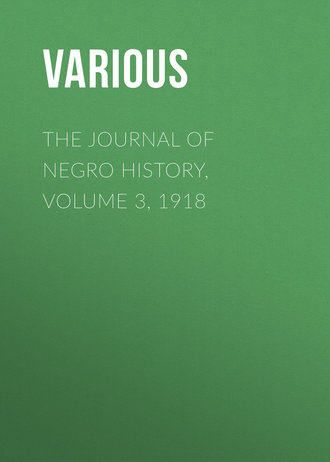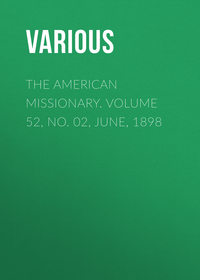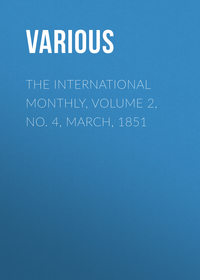 полная версия
полная версияThe Journal of Negro History, Volume 3, 1918
The accomplishment of this task of reducing the free people of color to the status of the blacks, however, was not easy. In the first place, so many persons of color had risen to positions of usefulness among progressive people and had formed connections with them that an abrupt separation was both inexpedient and undesirable. Exceptions to the hard and fast rules of caste were often made to relieve the people of color. Moreover, the miscegenation of the races in the South and especially in large cities like Charleston and New Orleans had gone to the extent that from these centers eventually went, as they do now, a large number of quadroons and octoroons,480 who elsewhere crossed over to the other race.
White men ashamed of the planters who abused helpless black women are now trying to minimize the prevalence of this custom. Such an effort, however, means little in the face of the facts that one seventh of the Negroes in the United States had in their veins any amount of Caucasian blood in 1860 and according to the last census more than one fifth of them have this infusion. Furthermore the testimony of travelers in this country during the slavery period support the contention that race admixture was common.481
So extensive did it become that the most prominent white men in the country did not escape. Benjamin Franklin seems to have made no secret of his associations with Negro women.482 Russell connects many of these cases with the master class in Virginia.483 There are now in Washington Negroes who call themselves the descendants of two Virginians who attained the presidency of the United States.
The abolitionists made positive statements about the mulatto offspring of Thomas Jefferson. Goodell lamented the fact that Jefferson in his will had to entreat the legislature of Virginia to confirm his bequest of freedom to his own reputed enslaved offspring that they might remain in the State of their nativity, where their families and connections were.484 Writing in 1845, the editor of the Cleveland American expressed regret that notwithstanding all the services and sacrifices of Jefferson in the establishment of the freedom of this country, his own son then living in Ohio was not allowed to vote or bear witness in a court of justice. The editor of the Ohio Star said: "We are not sure whether this is intended as a statement of actual fact, or of what might possibly and naturally enough be true." The Cincinnati Herald inquired: "Is this a fact? If so, it ought to be known. Perhaps 'the Democracy' might be induced to pass a special act in his favor." The Cleveland American, therefore, added: "We are credibly informed that a natural son of Jefferson by the celebrated 'Black Sal,' a person of no little renown in the politics of 1800 and thereafter, is now living in a central county of Ohio. We shall endeavor to get at the truth of the matter and make public the result of our inquiries."485
A later report of miscegenation of this kind was recorded by Jane Grey Swisshelm in her Half a Century, where she states that a daughter of President John Tyler "ran away with the man she loved in order that she might be married, but for this they must reach foreign soil. A young lady of the White House could not marry the man of her choice in the United States. The lovers were captured and she was brought to His Excellency, her father, who sold her to a slave-trader. From that Washington slave-pen she was taken to New Orleans by a man who expected to get twenty-five hundred dollars for her on account of her great beauty.486
Carter G. WoodsonGERRIT SMITH'S EFFORT IN BEHALF OF THE NEGROES IN NEW YORK
During the first half of the nineteenth century, the condition of the free Negroes in the Southern States became more and more critical. The doctrine of the rights of man, which had swept over the world in the latter part of the eighteenth century had had its effect on the colonists and resulted in the manumission of many slaves. These freedmen taking advantage of their economic and educational opportunities became an ever increasing menace to the social institutions that had no foundation except that of slavery. Ambitious, often aggressive, they were a constant source of dissatisfaction because of the unhappy comparison of their lot with that of the slaves. They, moreover, encouraged the slaves to improve their condition and to escape to the North. This situation was rendered still more critical for the reason that the South, considering slavery indispensable to its economic life, was already being lashed into a frenzy to gain new slave territory and to strengthen the institution by every possible method of oppression of the blacks. Measures inimical to the economic progress of freedmen were enacted.487 Many who had been manumitted were seized and again reduced to slavery. Educational opportunities were restricted or denied. Legally they were without voice and hence could secure no redress when wronged.488
This economic poverty, insecurity of personal liberty, and absolutely negative political status, impelled the freedmen to find better conditions in the North. The reaction against plantation life and the glittering attractions of the large city with the prospect of earning money less arduously no doubt account for their influx into the industrial centers.489 These free blacks migrated in great numbers especially to New York and Philadelphia. The Colonization Society attempted to solve the problem by effecting the colonization of the free Negroes somewhere either within or without the United States. Many friends of the Negroes and even some of the Negroes themselves thought favorably of the idea and a few small colonies were formed in the Western States and in Liberia.490
Among the anti-slavery men who at first saw no fault in the aims of the Colonization Society was Gerrit Smith. The son of a slave owner in the State of New York, he was acquainted with slavery in the milder form in which it existed in the North. It was just two years before his birth that the legislature of New York passed its act of emancipation providing that all children after the year 1799 should be free, the males on reaching the age of twenty-eight years and the female twenty-five. His father, Peter Smith, was a slaveholder and the owner of extensive lands in the counties of northern New York; and even before his death the management of these vast properties devolved upon his son.
He soon became deeply interested in the uplift of the slaves and endeavored to improve their condition by gradual emancipation looking forward to colonization. As early as 1834, his diary shows a growing belief in the universal right to liberty. Years ripened this belief and also developed his anti-land-monopolist principles, both of which reached fruition in his act of 1846, by which he gave away thousands of acres of land. He severed his connection with the Colonization Society when that body overtly declared that it was not a society for the abolition of slavery nor for the improvement of the blacks nor for the suppression of the slave trade, and he threw his energy into the work of abolition as fervently, if not as drastically, as Garrison.491
Anti-land-monopolist as he was, Gerrit Smith believed that the life of the small free farmer was calculated to develop thrift and self respect in the character of the colored freedmen that he saw crowded in sections of the large cities. For although enjoying greater security of personal liberty, the mass of colored people in New York State had not made much economic progress, even to the extent of possessing property valued at two hundred and fifty dollars, which in that State would have entitled them to the right to vote.492 He said that he had for years indulged the thought that when he had sold enough land to pay his debts, he would give away the remainder to the poor. He was an Agrarian, who wanted every man desirous to own a farm to have one. He, therefore, felt that it was safe to make a beginning in the work of distributing land to individuals. He had theretofore given tracts of land to public institutions and a few small parcels to individuals, but had not entered upon the larger task of making large donations of land to the poor.
He then planned to transfer three thousand parcels of land of forty to sixty acres each during the following three years. To whom among the poor he should make these deeds, was a question he could not hastily solve. He was sure, however, that, inasmuch as his home and the land were both in the State of New York, it would be very suitable to select his beneficiaries from among the people of that State. But for a long time, he was at a loss to decide, whether to take his beneficiaries generally from the meritorious poor or only from the deserving Negroes. He said, "I could not put a bounty on color. I shrank from the least appearance of doing so, and if I know my heart, it was equally compassionate toward such white and black men as are equal sufferers."493 In the end, however, he concluded to confine his gifts to Negroes.
He would not have come to this conclusion he said, if the land he had to give away had been several times as much as it was, nor if the Negroes, the poorest of the poor, had not been the most deeply wronged class of the citizens. "That they are so," said he, "is evident, if only from the fact, that the cruel, killing, Heaven-defying prejudice of which they are victims, has closed against them the avenues to riches and respectability—to happiness and usefulness. That they are so, is also evident from the fact, that, whilst white men in this State, however destitute of property, are allowed to vote for Civil Rulers, every colored man in it who does not own landed estate to the value of two-hundred and fifty dollars, is excluded from the exercise of this natural and indispensably protective right."494 He confessed that he was influenced by the consideration that there was great encouragement to improve the condition of the Negroes, because every amelioration in it contributed to loosen the bands of the enslaved portion of their outraged and afflicted race.
He, therefore, requested Reverend Theodore S. Wright, Reverend Charles B. Ray, and Dr. J. McCune Smith, three representative Negroes of New York City, to make out a list of the Negroes who should receive from him parcels of land. His only restrictions upon them in making this selection were that they should choose no person younger than twenty-one and no person older than sixty; that they accept no person who was in easy circumstances as to property; and no one who was already the owner of land, and no drunkards.495 He further promised to pay all taxes as well as purchase money and interest due to the State of New York hoping that none of the parcels would be sold for the nonpayment of taxes.496 The total number of colonists were to be one thousand nine hundred and eighty-five, to be distributed as follows: in the county of Suffolk, 127; Queens, 215; Kings, 197; New York, 861; Richmond, 832; Rockland, 331; Westchester, 115; Dutchess, 150; Sullivan, 5; Ulster, 106; Orange, 136; and Putnam, 10. Although this distribution was suggested the actual grants seem to have been made in the counties of Franklin, Essex, Hamilton, Fulton, Oneida, Delaware, Madison and Ulster.
On September 9, 1846, he wrote again to three gentlemen of color, saying that a thousand of the deeds were already in the hands of the committee for distribution. He had saved them the expense of securing the certificate of the County Clerk by having the acknowledgment of the execution taken by a Supreme Court judge. The only expense left for the beneficiaries to bear was the recording of the deed. The letter closed with a request that the three gentlemen prepare and send out a circular among the persons receiving the deeds, making known to them the conditions and reasons which actuated him in bestowing the land. This was done and the recipients were exhorted to profit by the chance to become land owners and thereby secure their right to vote.
These lands, as Smith realized and admitted, were not all arable but many of them had considerable timber. Such property today would be considered valuable, but in those days of plentitude it passed as undesirable. Some of his enemies accused him of making for himself a reputation for generosity by giving away useless land. There is no evidence, however, that such accusations were made by the Negroes.497 But be that as it may, the experiment was a failure. It was not successful because of the intractability of the land, the harshness of the climate, and in a great measure, the inefficiency of the settlers. They had none of the qualities of farmers. Furthermore, having been disabled by infirmities and vices they could not as beneficiaries answer the call of the benefactor. Peterboro, the town opened to Negroes in this section did maintain a school and served as a station of the underground railroad but the agricultural results expected of the enterprise never materialized.498 The main trouble in this case was the impossibility of substituting something foreign for individual enterprise.
The failure of the enterprise did not cause this philanthropist to cease his activities in behalf of freedom and justice to the Negroes. He continued a staunch abolitionist, demanding unconditional emancipation of the slaves and leaving undone nothing which might effect this change. He was once intimately associated with John Brown, who at one time left his home and purchased from Smith a farm in the Negro colony in order to live with the blacks and help them to improve their economic condition. Smith lived until 1874, long enough to see the Negroes freed and many of them making elsewhere that economic progress which was the dream of his earlier years.
Zita DysonTHE BUXTON SETTLEMENT IN CANADA
The Buxton, or Elgin Association Settlement, in Kent county, western Ontario, was in many respects the most important attempt made before the Civil War to found a Negro refugee colony in Canada. In population, material wealth and general organization it was outstanding, and the firm foundation upon which it was established is shown by the fact that today, more than half a century after emancipation, it is still a prosperous and distinctly Negro settlement.
The western peninsula of Ontario, lying between Lakes Huron and Erie, was long the Mecca of the fugitive slave. Bounded on the east by the State of New York, on the west by Michigan, and on the south by Ohio and northwestern Pennsylvania, this was the part of Canada most easily reached by the fugitive; and Niagara, Cleveland, Detroit and other lake ports saw thousands of refugees cross narrow strips of water to "shake the lion's paw" and find freedom in the British queen's dominions. During the forties and fifties there was a constant stream of refugees into Canada. As many as thirty in a day would cross the Detroit River at Fort Malden alone. Many of these went to the cities and towns, but others found greater happiness in the separate Negro communities which grew up here and there.
The history of the Buxton settlement, one of these, is closely linked with the name of Rev. William King. King was a native of Londonderry, Ireland, a graduate of Glasgow College, who had emigrated to the United States and become rector of a college in Louisiana. Later he returned to Scotland, studied theology in the Free Church College, Edinburgh, and in 1846 was sent out to Canada as a missionary of the Free Church of Scotland. While he was living in Louisiana he became, through marriage, the owner of fifteen slaves of an estimated value of $9,000. For a time he placed them on a neighboring plantation and gave them the proceeds of their labor but that did not satisfy his conscience and in 1848 he brought them to Canada, thereby automatically giving them their freedom. His effort on their behalf did not end here. Having brought them to this new country, he felt it a duty to look after them, to educate and make of them useful citizens. The same thing, he believed, could be done for others in like circumstance.
The first effort to secure a tract of land for the refugees was made by the Rev. Mr. King as the representative of the Presbyterian Church. This application was before the Executive Council of the Canadian Government in September, 1848, but was not successful. Steps were at once taken to organize a non-sectarian body to deal with the government and this new body took the name of the Elgin Association in honor of the then governor-general of the Canadas who seems to have been well disposed toward the refugees. The Elgin Association was legally incorporated "for the settlement and moral improvement of the colored population of Canada, for the purpose of purchasing crown or clergy reserve lands in the township of Raleigh and settling the same with colored families resident in Canada of approved moral character."499 Rev. Dr. Connor was the first president; Rev. Dr. Willis, of Knox College, Toronto, first vice-president, and Rev. William King, second vice-president. J. T. Matthews was the secretary, J. S. Howard, treasurer, while the original directors were E. A. T. McCord, Walter McFarland, Peter Freland, Charles Bercsy, W. R. Abbott, John Laidlaw, E. F. Whittesend and James Brown. These are the names that appear upon the petition to the government for lands, the original of which is in the Dominion Archives.
There were difficulties in securing the land. Decided opposition to the whole project made itself manifest in Kent county.500 In Chatham, the county town, a meeting of protest was held. The plans of the Elgin Association were condemned and a resolution was passed setting forth objections to selling any of the public domain "to foreigners, the more so when such persons belong to a different branch of the human family and are black." A vigilance committee was appointed to watch the operations of the Elgin Association while the various township councils interested were requested to advance the necessary funds for carrying on the campaign. That there was some dissent, however, even in Chatham is shown by the fact that one Henry Gouins was allowed to speak in favor of the Association. The vigilance committee soon issued a small pamphlet, made up chiefly of the speeches and resolutions of the public meeting. The name of Edwin Larwill, member of Parliament for the county of Kent, appears as one of those most active in opposition to the settlement plan. Larwill had a record for hostility to the colored people though at election times he was accustomed to parade as their friend. In 1856 he introduced in the House of Assembly a most insulting resolution501 calling for a report from the government on "all negro or colored, male or female quadroon, mulatto, samboes, half breeds or mules, mongrels or conglomerates" in public institutions. Larwill was at once called to account for his action and a resolution was introduced calling upon him to retract.
The opposition of Larwill and his supporters failed to impede the progress of the Association and a tract of about 9000 acres, lying to the south of Chatham and within a mile or two of Lake Erie, was purchased. This was surveyed and divided into small farms of fifty acres each, roads were cut through the dense forest and the first settlers began the arduous work of clearing. The colonists were allowed to take up fifty acres each at a price of $2.50 per acre, payable in ten annual instalments.502 Each settler was bound within a certain period to build a house at least as good as the model house set up by the Association, to provide himself with necessary implements and to proceed with the work of clearing land. The model house after which nearly all the dwellings were copied was 18 by 24 feet, 12 feet in height and with a stoop running the length of the front. Some of the settlers were ambitious enough to build larger and better houses but there were none inferior to the model. The tract of country upon which the settlers were located was an almost unbroken forest. The ground was level, heavily timbered with oak, hickory, beech, elm, etc. Part of the soil was a deep rich black loam. Trees two to four feet in diameter were common and the roads cut through to open up settlement were hardly more than wide lanes. Rev. Mr. King thought that one reason for the colony's success was the fact that so many of the settlers were good axe men. Their industry was remarkable and some of the more industrious paid for their land in five or six years and took up more to clear.503
There are several contemporary references to the sobriety and morality of the colonists. The New York Tribune correspondent in 1857 was able to report that liquor was neither made nor sold in the colony and that drunkenness was unknown. There was no illegitimacy and there had been but one arrest for violation of the Canadian laws in the seven years of the colony's history. Though the Presbyterian church gave special attention to the Buxton colony this did not hinder the growth of other sects, Methodists and Baptists both being numerous, though the best of feeling seems to have prevailed and many who retained their own connection were fairly regular attendants at Mr. King's services.
The Tribune article gives an interesting description of the homes. The cabins, though rough and rude, were covered with vines and creepers with bright flowers and vegetable gardens round about. Despite the pioneer conditions there abounded comfort and plenty of plain homemade furniture. Pork, potatoes and green corn were staple items of the menu. Of King's former slaves the Tribune reports that three had died, nine were at Buxton, one was married and living in Chatham and two others in Detroit were about to return. The Tribune reports on one case as typical of what was being achieved by the colony. A colored man, fourteen years before a slave in Missouri and who had been at Buxton six years, reported that he had 24 acres out of his plot cleared, fenced and under cultivation. On six acres more the trees were felled. He had paid four installments on his farm, owned a yoke of oxen, a wagon and a mare and two colts. His fourteen-year-old boy was at school and was reading Virgil. In the home, besides bed and bedding, chairs and tables, there was a rocking chair and a large, new safe. Water was brought to the visitor in a clean tumbler, set upon a plate. A neighboring cabin had carpet on the floor and some crude prints on the walls. All the cabins had large brick fireplaces. Rev. Mr. King's own house, built of logs with high steep roof, dormer windows and a porch the whole length, was somewhat larger than the others.504
What these people actually accomplished at Buxton amid conditions so different from what they had known in the past is altogether remarkable. Some had known little of farm work before coming to the colony while all of them must have found the Canadian climate something of a hardship even in the summer. Outside of the farm work they showed ability as mechanics and tradesmen. One who visited them in the fifties says:505
"The best country tavern in Kent is kept by Mr. West, at Buxton. Mr. T. Stringer is one of the most enterprising tradesmen in the county, and he is a Buxtonian, a colored man. I broke my carriage near there. The woodwork, as well as the iron, was broken. I never had better repairing done to either the woodwork or the ironwork of my carriage, I never had better shoeing than was done to my horses, in Buxton, in Feb., 1852, by a black man, a native of Kentucky—in a word, the work was done after the pattern of Charles Peyton Lucas. They are blessed with able mechanics, good farmers, enterprising men, and women worthy of them and they are training the rising generation to principles such as will give them the best places in the esteem and the service of their countrymen at some day not far distant."
A few years sufficed to remove most of the prejudice that had shown itself in the opposition of the Larwill faction at Chatham at the inception of the colony. When Rev. S. R. Ward visited the colony in the early fifties he found that instead of lowering land values of adjoining property as some had predicted would result from establishing a Negro colony in Kent county, the Buxton settlement had actually raised the value of adjoining farms. The Buxton settlers were spoken of by the white people as good farmers, good customers and good neighbors. There were white children attending the Buxton school and white people in their Sunday church services.
Perhaps no finer testimony to the success of the whole undertaking is recorded than that of Dr. Samuel R. Howe who came to Canada for the Freedmen's Inquiry Committee.











